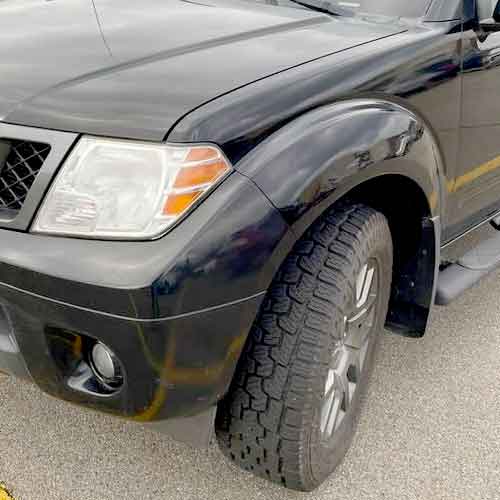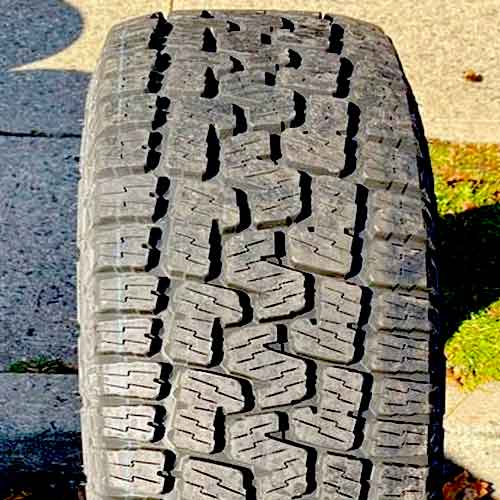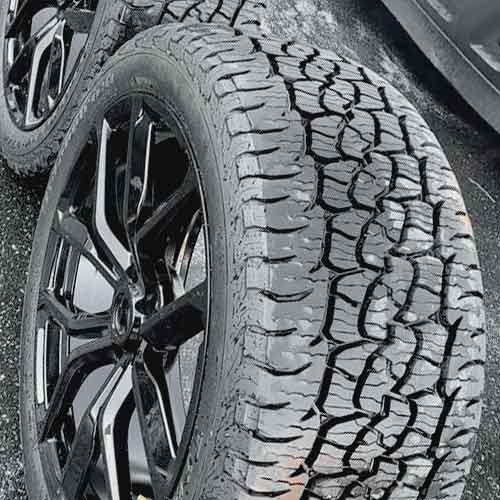If you’re in need of a tire that can handle any terrain and any vehicle, look no further than Pirelli Scorpion All Terrain Plus and BF Goodrich Trail Terrain! These all-terrain giants are built for light trucks, pickups, and even SUVs. They can take a lot of mild off-road challenge with ease and on roads, there are no complaints either.

Being a tire engineer, from my perspective, the Pirelli Scorpion A/T Plus has better highway capability but only when things are dry, though it’s wet traction is also better here as well, as BFG Trail Terrain lacks in that area a lot with it’s under-steering. Off road, both tires are great, but the bigger piece of the pie is again taken by Pirelli. BF Goodrich Trail is basically better in other on-road areas, like fuel economy, highway comfort and wear resistance.
Sizes Info
Starting with BF Goodrich Trail Terrain, it comes in 44 sizes in 15 to 22 inches. They have following specs.
- Speed Ratings: T and H.
- Load Ratings: XL and SL.
- Tread depth: 12.5/32″ on all.
- Weight Range: 32 to 46 lbs.
- 60k Miles warranty.
- Internal construction: 2 ply polyester + 2 steel belts + 1 nylon cap ply.
Pirelli Scorpion AT Plus on the other side, comes in only 22 sizes, in 16 to 20 inches, with following specs.
- Speed Ratings: R, S, T and H.
- Load Ratings: XL, SL, D and E.
- Tread depth: 13 to 16/32″
- Weight Range: 29 to 60 lbs.
- 50k Miles warranty.
- Internal construction: 2 ply polyester + 2 steel belts + 2 nylon cap plies.
Tread Design
The Pirelli Scorpion All Terrain Plus tire shows up with a unique tread pattern, that is meant to represent the initials for “Pirelli Scorpion” with its “P” and “S” shaped blocks in the middle.

Though one might say, P looks more like a J, though it’s not for looks, as they serve a very functional purpose.
These blocks are equipped with full depth interlocking 3D sipes, and sharp edges, with twists and turns that provide “efficient” biting on a variety of terrains.
The rubber composition of its tread is slightly softer, but the blocks are still supported by foundations underneath to maintain firm stability, and handle the demands of rougher paths.
When we look at the sides of the tire, we find that they have many of the same features, the notches, siping, off-set edges, everything is similar.
Though these lugs are smaller in comparison, as it’s evident.
Furthermore, on the outer edges, the tire features staggered shoulder lugs that are engraved with voids (on their outer extremities). And this, combined with (slanted) U shaped sidewall lugs, it yields great off-road bite and footprint (with lowered tire’s air pressure, of course).
Moving on to other, the BF Goodrich Trail Terrain features slightly aggressive outer edges.

It presents with thicker sidewall lugs, are bigger scoops on staggered shoulders, along with deep curved notches.
Though from inside, it forms a continuous running (shoulder) rib, with zigzag siping.
Moving towards the middle, here you see 3 ribs with very similar looking lugs.
They carry full depth sipes to them (which are capable of splitting open the blocks, promoting off-road bite).
And all these ribs form a great self cleaning groove pattern, where the lateral ones easily meet the outer (wider) circumferential channels.
Furthermore, the tire does not have traditional stone ejectors as there are no gaps between the shoulder blocks, but it does feature triangular ones hidden inside the middle grooves.
And these further aid to cleaning off any kind of unwanted dirt particles.
Dry Performance
Dry performance is judged by looking at the tire’s “directional” grip, handling and steering responsiveness. Lets discuss them all.
Directional Grip
When it comes to directional grip, although the footprint of the tread from the middle, decides the braking and acceleration performances, both tires provide almost equal contact (with the road) from there.
But still with a smaller difference, the BF Goodrich Trail Terrain does better (as it shows slightly shorter braking distances).
That’s because it offers a more on-road streamlined design, where you get to have 3 ribs in the middle, though slanted, still making 4 circumferential channels (this type of design has directional edge over others).
Moreover, with full depth siping it’s lugs get to have the option of splitting (as mentioned in it’s design section), and this offers more biters during braking and acceleration.
Furthermore, BF Goodrich, has a habit of making rounded tires (contact patch), so with this, the tires geometry meeting with the surface has a curve to it, which enforces the middle area of the tread to meet up with more forces making directional grip better.
The Pirelli Scorpion on the other side, does not offer these features, and so it lacks slightly, though both tires have similar speed ratings going up to H.
Dry Handling
The lateral traction of a tire, or its ability to corner, is largely determined by the tread structure and composition of the shoulder lugs. These lugs must have a strong bond with the road to maintain traction during turns.
So here, the BF Goodrich Trail Terrain does better, and its not surprising at all, as its shoulder rib make a consistent connection with the road, which means there aren’t any grooves in the way, so lateral traction gets enhanced.
The Pirelli All-Terrain Plus in comparison, has smaller lugs there with notches, and a lot of empty spacing (with grooves). So where it’s lugs are more susceptible to flexing (wasting energy), they also eat away the rubber that could have been in contact with the surface.
Steering Response
Steering response, or steering sensitivity, is an important performance metric that determines how easily the tires can be maneuvered. This is often overlooked, but can greatly impact the overall handling performance.
With consistent design and rounded contact patch, the BFG Trail produces a more desirable results.
The rounded contact patch allows smoother transition of weight form the middle section towards shoulders as the tire turns, and the continuous rib there offers an unbreakable contact with the ground at all times, so there isn’t any lag between the steering inputs and the handling feedback.
Pirelli Scorpion AT plus on the other side, with it’s smaller lugs can’t offer similar responsiveness, though it’s stiffer compound helps it a little bit.
Wet Traction
On wet roads although both tires aren’t so great, compared to other all-terrain tires, the Pirelli Scorpion AT Plus still does a better job, (though its sipes are not as interlocking).
That’s because wet traction has to do with faster water removal, and here two things have a huge role to play, sipes, and grooves.
As the tire meets with the watery surface, most of the water is expelled out with the help of grooves, the little that’s left behind, is dealt with sipes.
Now, when it comes to BF Goodrich Trail Terrain, with packed up shoulder ribs, there’s no sideways water removal there, and so it’s middle sipes suffers (as they have more work to do).
That’s why even though it’s sipes are flexible and efficient enough, the overall wet traction is still not ample.
The Pirelli Scorpion AT+ on the other side, provides efficient water removal in all directions and the rest is wiped off by it sipes.
Fuel Consumption
Fuel is although largely dependent on the rolling resistance, it also factors in, weight, composition and structure.
And with that, it tells how much pressure is being put on each lug, or in other words, with how much forces are those lugs getting rubbed off on pavements.
Both of these tires are although very fuel efficient, the BF Goodrich Trail Terrain still takes a very slight upper hand.
The tire is much lighter and it distributes its weight very evenly across all its ribs, as well.
Moreover, its on road design having 3 longitudinal ribs in the middle, also act as a catalyst against fuel consumption.
Pirelli Scorpion A/T Plus in comparison, is more voided, so each of its lug has to bear more pressure on it, which results in slightly higher fuel consumption.
Recommended Read: Do all-terrain tires show worse gas mileage?
Tread Life
Rolling resistance is affecting this area too, sure, but there are other influencing things that fight against wear, and these include tread depth and rubber composition, though both of them are not helping Pirelli’s boy here.
The BF Goodrich Trail Terrain yields less rolling resistance values, so even with it’s softer compound, it’s still able to survive much longer.
That’s because it’s packed up lugs, especially on shoulders (which take a larger portion of the tread’s surface area), don’t cause as much flexing, so less heat is generated, which indirectly helps with wear.
Pirelli Scorpion AT Plus on the other hand, even with its’ larger tread depth offers less overall mileage, as it’s offset edges, and notches bite in the surface with more force, rendering it to burn of faster.
That’s why it gives 10k less mileage warranty in comparison.
Noise
Noise is just air particles hitting around the tread. And that air comes in mostly through the shoulders.
That’s why with continuous design, the BF Goodrich Trail Terrain is one of the most silent A/T tires, that you can get (see this list to find which is the most silent).
Pirelli Scorpion AT Plus although made a lot of improvements over it’s previous model (ATR), it’s still pretty loud. Looks like they have to work on it some more.
Winter Traction
Winter traction is determined by a tire’s ability to maintain forward momentum, cornering capability, and braking response on all types snowy surfaces.
The BF Goodrich Trail Terrain is basically a better tire here overall, though both of them have 3 peak mountain snowflake ratings.
It’s sipes are basically designed for snow (though it lacks a lot on wet, as you’ve seen already, above).
The Pirelli Scorpion AT Plus on the other hand, also offers a good snow grabbing abilities, but it’s stiffer compound combined with less overall biters, its not able to outperform its competitor.
Off Road Traction
Off road is just a single word which opens up to a lot of variations, though I sorted it out by mentioning different terrains below, and how these tires performed on all of them. Let’s dig in (no pun intended).
On Mud
On mud you need a lot tread voids, otherwise the slimy material of mud would get lodged in and pack up any tire.
Having said that, the Pirelli Scorpion does a better job here with it’s much more efficient self cleaning channels. The tire has central lugs making a map of grooves running in all directions, and it’s shoulder lugs are not joined up.
It’s quite the opposite on BFG Trail Terrain, as this tire has continuous running shoulder ribs, disallowing mud to leave sideways.
On Rocks
Basically on rocks, you need flexibility so groove and notches can expand/contract to bite in. And BFG Trail lacks in providing that, even with its softer composition.
Although its shoulder ribs have a lot of biters, with continuous design, they are very much restricted to move. So you get only directional grip on this tire.
Though with powerful sidewalls, lowering air pressure on this tire really does wonders for it.
Though still, Pirelli Scorpion AT Plus takes the upper hand here, as it’s biters everywhere are more flexing, and it’s slanted U shaped lugs offer lateral traction in a much better way.
Though with just 2 ply sidewalls, it’s not recommended that you take these tires on more rugged tracks, keep it light guys.
On Sand
Basically on sand you need a floating tire, so although an ideal pick for this terrain would be “a balloon tire”, A/Ts still get the job done if you lower down their air pressure (which basically enhances footprint with the sand).
So with lowered PSI, the rounded contact patch of BFG Trail Terrain yields better results, as there isn’t too much digging going on, allowing it to gain forward momentum much more easily (in comparison).
Pirelli Scorpion on the other side, is also good enough, but the tire offering less section width (on average) simply digs in way more. And weight further acts as a catalyst there, as BFG Trail Terrain last sizes is only 46 lbs.
Take Home Points
Both tires are mild all-terrain tires, and out of them, the BF Goodrich Trail Terrain performs better on dry roads, in terms of traction, noise, fuel economy and wear.
In comparison, on Pirelli Scorpion AT+, you get to have superior off road capability, and wet traction on highways.